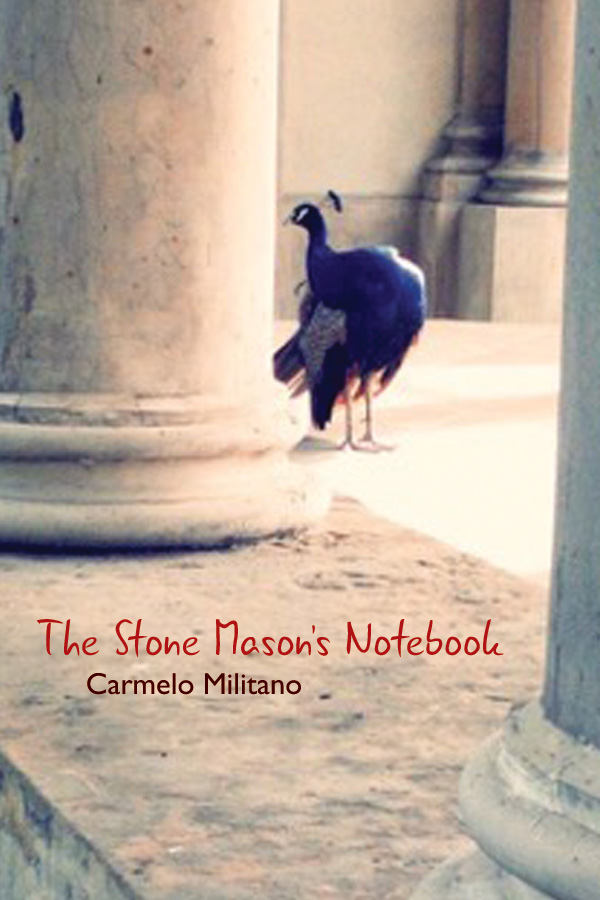REVIEW: THE STONE MASON'S NOTEBOOK | BY CARMELO MILITANO
 Ekstasis Editions | 66 pages | 2016 | $23.95 | Purchase online
Ekstasis Editions | 66 pages | 2016 | $23.95 | Purchase online
Review by Bianca Lakoseljac
—
If Carmelo Militano fans have been longing for a new book of poems, The Stone Mason’s Notebook, Militano’s fifth collection, is a welcome gift of thoughtful lyrical exploration of love, of human existence, of personal history and the importance of place, and above all, of the drive to create. Whether set in the poet’s native Calabria or in Winnipeg, his hometown—or an abode in his mind’s eye—his poems invite the reader into a place of mythical vision, at once real and surreal.
“Modi’s Model” is Militano’s imaginative rendition of Amedeo Modigliani’s creative vision, where the poet takes on the voice of Modigliani’s model:
“I [the model] arrived next day and after a brief hello
Asked me to undress but not before 5 francs I insisted
He [Modigliani] offered immortality which is never edible
The light was weak so he opened the front doors
Swept his hand out towards distant blue boulevard rooftops
Eternal grey Paris sky…”
Militano takes the reader on a journey, from the dark corridors of Modigliani’s “La Rotonde” he describes as “windowless and dark like his [Modigliani’s] eyes,” through the “sweet mutterings of birds at dusk in summer,” and “eternal … Paris sky,” hence inviting the reader to submerge into Modigliani’s artistic milieu. The poem ends in a witty and clever stanza, “I [Modigliani] suffer for my art unlike that fraud Picasso,” and leaves the reader with a chuckle and admiration for Militano’s witty way of hinting at Modigliani’s collegial rivalry with his peers, including Picasso who, as Militano informs us in his Acknowledgements, led the procession at Modigliani’s funeral and was crushed by the artist’s early death at the age of thirty five.
In “Spirit World,” apparitions dwell parallel to town-folk going about their everyday chores—baking bread, sewing clothes, or making pasta sauce—each aware of the other yet undisturbed, sharing this enchanted existence. And it is the juxtaposition of the tangible, material world, and the intangible, spiritual one, that renders these poems timeless and unforgettable:
“Before this she sang with a shy voice
Hymns at early morning mass
As mist rose off winter fields
Spirits floated up with the mist
Like grey white scarves and caressed trunks
Of olive trees below the village of Cosoleto.”
In “The Keys,” the reader is lead into another dreamlike world, that of the poet’s childhood memory brought to life by the landscape and people who emerge into reality from their shrouded existence of his remembrance—only to arrive at a philosophical conclusion depicted as, “beautiful silence all the way home a partial answer/to why we never look back.”
Militano’s poems embody various themes and blend occurrences from his own life with scenes from the lives of artists from the past, thus relating current events to historical ones, and painting an artistic milieu of congeniality and conviviality, where, as seen in “La Rotonde,” the artists could introduce, showcase, and nurture each other’s art—not unlike Militano’s own artistic ambiance enriched by the network of writers, artists, and art lovers from all walks of life.
Carmelo Militano’s The Stone Mason’s Notebook has been referred to as lyrical, passionate, reflective, ironic, and wise. It is an invite to enter the poet’s world, journey through his mythical vision, and emerge enlightened.
—
Bianca Lakoseljac is a Toronto poet, novelist, short story writer, essayist, book reviewer, and educator. Her latest book, Stone Woman—a novel that relives Toronto’s 1967 summer of love—was published in fall 2016, by Guernica Editions. Her poems have appeared in various anthologies such as 50+ Poems for Gordon Lightfoot. www.biancalakoseljac.ca.
